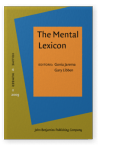Vol. 4:2 (2009) ► pp.276–301
Why are Noun-Verb-er compounds so difficult for English-speaking children?
Preschool children who attempt novel NV-er compounds (like cat brusher) often misorder the noun and the verb, arguably based on sentential phrasal ordering (e.g., Clark, Hecht, & Mulford, 1986). In this study, we test this argument by replicating Clark’s prediction that children’s attempts will fall into predictable stages based on age and by comparing children’s production of NV-er compounds with another construction that violates sentential phrasal ordering: Verb-ingNoun phrases. Our studies show that we could not replicate the stages described by Clark and that children were more likely to produce Verb-ingNoun constructions in the target order than NV-er. However, the children’s constructions showed a contingency between the order of the elements and the children’s choice of morpheme, suggesting that they were often aiming for the target form. These results suggest that children do not misorder nouns and verbs in NV-er compounds because of phrasal ordering. We discuss possible alternatives for why NV-er compounds are difficult for preschool children.
Cited by (2)
Cited by 2 other publications
This list is based on CrossRef data as of 8 july 2024. Please note that it may not be complete. Sources presented here have been supplied by the respective publishers. Any errors therein should be reported to them.
